*NURSING > EXAM > LEMONE/BURKE/BAULDOFF, MEDICAL-SURGICAL NURSING 5TH EDITION TEST BANK Chapter 21 (All)
LEMONE/BURKE/BAULDOFF, MEDICAL-SURGICAL NURSING 5TH EDITION TEST BANK Chapter 21
Document Content and Description Below
LEMONE/BURKE/BAULDOFF, MEDICAL-SURGICAL NURSING 5TH EDITION TEST BANK Chapter 21 Question 1 Type: MCSA A 16-year-old patient in an outpatient setting with a body mass index of 35 tells a nurse “I am... going to lose weight by eliminating all fat from my diet.” Which of these actions is most appropriate for the nurse to take? 1. Contact the physician. 2. Notify the patient’s parents. 3. Refer the patient to a dietitian. 4. Discuss the role of fat in metabolism. Correct Answer: 4 Question 2 Type: MCSA A nurse is caring for a patient with multiple skin lesions who reports using a very-low-calorie diet in order to maintain weight loss. These patient findings would help substantiate a priority nursing diagnosis of which of the following? 1. Nutrition: Less than Body Requirements 2. Activity Intolerance 3. Ineffective Tissue Perfusion 4. Self Neglect Correct Answer: 1 Question 3 Type: MCSA A nurse is developing a plan of care with a patient who states, “I would like to conceive a child and want to eat a healthful diet.” Which of these outcomes should receive priority in the plan? The patient will consume which of the following? 1. potatoes, tomatoes, and sweet potatoes 2. dark green vegetables, lean beef, and eggs 3. liver, legumes, and citrus fruits 4. whole grains, yeast breads, and milk Correct Answer: 2 Question 4 Type: MCSA A nurse is caring for a patient who states, “I take large doses of vitamin A because it makes my skin healthy.” What is the nurse’s best response to this statement? 1. “This is a great idea.” 2. “This will not benefit your skin. You excrete high doses of vitamin A in your urine.” 3. “You should take vitamin C to balance the large dose of A.” 4. “Too much vitamin A can become toxic to your body.” Correct Answer: 4 Question 5 Type: MCSA A nurse is caring for a patient with an order for a liver biopsy. Which of these measures should be included in the plan of care? 1. The patient will be n.p.o. at least 8 hours prior to the procedure. 2. The patient must eat a low-fat diet 1-3 days prior to the procedure. 3. Blood tests will be ordered prior to the procedure. 4. Activity will be limited for 4-6 weeks after the procedure. Correct Answer: 3 Question 6 Type: MCSA Which of the following statements would be important for a nurse to ask a patient to most effectively assess the patient’s pattern of elimination? 1. “Are you having any bowel problems?” 2. “Have you had any recent difficulties with your stools?” 3. “Tell me about your usual bowel habits.” 4. “Are your bowel movements normal?” Correct Answer: 3 Question 7 Type: SEQ A nurse asks a nursing student to describe the four parts of abdominal assessment in proper order. Standard Text: Click and drag the options below to move them up or down. Choice 1. percussion Choice 2. inspection Choice 3. palpation Choice 4. auscultation . Question 8 Type: MCSA A nurse is caring for a patient who has purposefully decreased caloric intake and increased activity levels and undergone an assessment of body mass index. The findings are 22 kg/m2. Based on this finding the nurse should recognize which of the following? 1. The patient’s weight is in a healthful range. 2. Further weight reduction is still needed to ensure health. 3. The patient is mildly obese. 4. The patient’s body mass index is below normal. Correct Answer: 1 Question 9 Type: MCSA The nurse is teaching a group of older adults about expected changes in dental health related to aging. Which of these statements, if made by one of the older adults, would indicate correct understanding of teaching? 1. “Dental health begins to decline with aging.” 2. “The loss of bone density with aging will result in tooth decay and breakage.” 3. “Increases in saliva production increase exposure of the tooth’s enamel to corrosive agents.” 4. “Metabolism changes in aging contribute to dental destruction.” Correct Answer: 2 Question 10 Type: MCSA The nurse is caring for a patient who has a two-month history of new onset diarrhea. The primary healthcare provider has ordered a diagnostic exam that uses radio-frequency waves and a magnetic field to evaluate disorders of the abdomen. The nurse recognizes this diagnostic test as which of the following? 1. a liver biopsy 2. a cholecystography 3. a gastric emptying study 4. a computed tomography Correct Answer: 4 Question 11 Type: MCSA Which of these questions would be the most important for a nurse to ask a patient who reports upper-right quadrant abdominal pain? 1. “Does the pain worsen when you inhale?” 2. “Do you have a history of diabetes?” 3. “When you eat do you experience any nausea?” 4. “Have your periods been normal?” Correct Answer: 1 Question 12 Type: MCSA A nurse is performing an abdominal assessment on a patient. When the patient turns from supine to the right side the nurse notes dullness on percussion. What is the best interpretation of this finding? 1. The patient is exhibiting normal findings. 2. The patient is exhibiting signs consistent with ascites. 3. The patient is exhibiting signs consistent with a bowel obstruction. 4. The patient is exhibiting signs consistent with hepatomegaly. Correct Answer: 2 Question 13 Type: MCSA The nurse is planning the diet for a patient scheduled to have a barium enema in two days. What should be included in the diet for the next 48 hours? 1. general diet 2. full diet today, clear liquids tomorrow 3. full liquids today, n.p.o. tomorrow 4. clear liquids both today and tomorrow Correct Answer: 2 Question 14 Type: MCSA Which of these priority measures should a nurse include in the discharge care plan for a patient who had a sigmoidoscopy with benign polyp removal? 1. Contact primary healthcare provider if large amounts of flatus result. 2. Avoid heavy lifting for two weeks after procedure. 3. Report abdominal pain, fever, or chills. 4. Eat foods high in fiber, beginning the evening of the procedure. Correct Answer: 3 Question 15 Type: MCSA An 85-year-old patient says to the nurse, “I don’t notice the sensation that I need to defecate as often as I noticed it in the past.” A nurse’s best response to this statement is which of the following? 1. “This is a normal part of aging due to slowed intestinal absorption.” 2. “As you age, the rectum loses tone, and there is a reduced sensation to defecate.” 3. “Have you had a colonoscopy in the past year to evaluate the condition?” 4. “Reduced vitamin K absorption is associated with this condition.” Correct Answer: 2 Question 16 Type: MCSA Which of these questions would be most important for a nurse to ask a patient who reports a change in bowel habits? 1. “Can you describe your activities in a normal day?” 2. “Do you have rectal pain?” 3. “Have your bowel changes created stress for you?” 4. “Can you describe the consistency of your bowel movements?” Correct Answer: 4 . Question 17 Type: MCSA A nurse is providing teaching for a patient scheduled for a colonoscopy. Which of these statements, if made by the patient, would indicate a need for further teaching? 1. “The procedure will only take about one hour.” 2. “It might be quite painful.” 3. “I will likely have medications that will make me drowsy during the test.” 4. “The physician might take tissue samples for further analysis.” Correct Answer: 2 Question 18 Type: MCSA The nurse is planning care for the patient who will have a barium enema the next morning. Which of the following should be included in the plan of care? 1. enemas after the procedure 2. full-liquid diet for 24 hours before the procedure 3. position the patient on the right side during the procedure 4. n.p.o. for eight hours prior to the procedure Correct Answer: 4 . Question 19 Type: MCSA During the admission assessment, the nurse learns the patient is having her menstrual period. Which of these ordered tests could be impacted by this finding? 1. small bowel series 2. barium enema 3. stool culture 4. colonoscopy Correct Answer: 3 Question 20 Type: MCSA The nurse is caring for a 60-year-old patient who is pale and reporting feelings of weakness. The patient’s hemoglobin level is 9 g/dL. The patient states, “I eat a healthful diet. Why am I not well?” The nurse’s best response is which of the following? 1. “You might not be eating as well as you think.” 2. “This happens as you get older.” 3. “As we age, the amount of iron absorbed by our body is decreased.” 4. “Menopause is responsible for these changes.” Correct Answer: 3 Question 21 Type: MCSA During the assessment of a patient’s abdomen, frequent pulsations are noted in the epigastric region. What action by the nurse is indicated? 1. Document the findings as hyperactive bowel sounds. 2. Review the patient’s medical records for signs and symptoms of cirrhosis may indicate ascites. 3. Note the time when the patient last voided. 4. Notify the physician related to the findings. Correct Answer: 4 Question 22 Type: MCSA A nurse assesses that a patient has all of these manifestations. Which one is likely related to a diagnosis of acute diverticulitis? 1. lower-right quadrant pain 2. lower-left quadrant pain 3. upper-middle abdominal pain 4. back pain and tenderness Correct Answer: 2 Question 23 Type: MCSA A patient presents with abdominal pain in the epigastric region, nausea, and vomiting. Laboratory results indicate serum WBC count of 10,000 cubic millimeters and serum amylase of 450 units/dL. These findings would help substantiate a priority nursing diagnoses of which of the following? 1. Risk for Infection 2. Nutrition: Less than Body Requirements 3. Acute Pain 4. Risk for Dysfunctional Gastrointestinal Motility Correct Answer: 3 Question 24 Type: MCSA A nurse assesses a patient who has a scaphoid abdomen and a serum albumin level of 2.0 g/dL. These findings are most likely related to a diagnosis of which of the following? 1. type 2 diabetes mellitus 2. Crohn’s disease 3. malnourishment 4. diverticulosis Correct Answer: 3 Question 25 Type: MCSA A nurse is providing teaching for a patient who will have a small bowel series. Which of the following statements by the patient indicates the need for further education? 1. “It is normal to experience constipation for a few days after the procedure.” 2. “I will need to increase my fluid intake the first few days after the procedure.” 3. “I might have a laxative prescribed after the procedure.” 4. “The barium will be inserted through my rectum.” Correct Answer: 1 Question 26 Type: MCSA A nurse is developing a plan of care with a patient who has an order for an abdominal ultrasound. Which of these instructions will the nurse give the patient? 1. Advise the technician if you suspect you are pregnant. 2. Drink 1-2 quarts of water one hour before the procedure. 3. Do not eat anything 8-12 hours before the procedure. 4. Take a laxative the evening before the procedure. Correct Answer: 3 Question 27 Type: MCSA Which of these questions would be the most important for a nurse to ask a patient who is reporting symptoms of constipation? “Have you been taking 1. any narcotic medications?” 2. any over-the-counter pain relievers?” 3. any over-the-counter sleep aids?” 4. oral contraceptives?” Correct Answer: 1 Question 28 Type: MCSA The nurse is planning care for a patient with end-stage renal disease who has a moderate daily protein restriction. Which of these menu choices would be most appropriate for this patient? 1. peanut butter sandwich and apple slices 2. bean soup and spinach salad 3. salmon fillet and asparagus 4. fried rice and fresh strawberries Correct Answer: 3 Question 29 Type: MCMA A nurse is planning an educational class for middle school students regarding nutrition. Which of these data points should be included in the presentation? Select all that apply. Standard Text: Select all that apply. 1. Sufficient dietary fats help people absorb vitamins. 2. Cholesterol is needed for proper hormonal function. 3. Fat tissue helps insulate the internal organs. 4. Vitamin K is made by action of ultraviolet radiation on the skin. 5. Vitamin D is synthesized by bacteria in the intestine. Correct Answer: 1,2,3 Question 30 Type: MCSA Which of these outcomes would be most appropriate to establish for an alert and oriented patient who has a nursing diagnosis of Nutrition: Less than Body Requirements? The patient will: 1. verbalize understanding of causative factors and necessary interventions. 2. maintain core temperature within normal range. 3. demonstrate adequate fluid balance. 4. verbalize sense of relaxation and well-being. Correct Answer: 1 Question 31 Type: MCSA A home health nurse is giving instructions to a patient about nutritional requirements regarding vitamins. Which of these statements, if made by the patient, would indicate the patient needs further instruction? 1. “I will follow the National Academy of Sciences recommendations for daily intake of vitamins.” 2. “I might need more or fewer vitamins than someone else based on my lifestyle.” 3. “Evidence-based practice sometimes changes the amount of a specific vitamin that is recommended.” 4. “Vitamins obtained through foods eaten are superior to those obtained through tablets and pills.” Correct Answer: 4 Question 32 Type: MCMA A patient tells a nurse, “I am going to eat an all-fruit diet. Nothing is more healthful than fruit. Do you think this is a good idea?”Appropriate responses by the nurse include which of the following? Standard Text: Select all that apply. 1. “Fruit is natural and a good source of carbohydrates.” 2. “Fruit is a good source of carbohydrates but a poor source of fats and protein.” 3. “Fruit supplies many important vitamins, but is a relatively poor source of minerals.” 4. “Incorporating fruit with complete sources of protein and healthful fats provides complete nutrition.” 5. “A fruit-based diet will reduce your risk of developing diabetes mellitus.” Correct Answer: 2,3,4 Question 33 Type: MCMA The nurse is teaching a group of 6-year-olds about the digestive system. The nurse knows teaching has been effective when the 6-year-olds make which of the following statements? Select all that apply. Standard Text: Select all that apply. 1. “Grown-ups have 28 teeth.” 2. “Spit helps you taste your food.” 3. “Food starts breaking down to be used for energy in the stomach.” 4. “It’s like a tube. Food I need goes in one end. What I don’t need comes out the other.” 5. “The food moves through the tube in waves, like a snake eating a mouse.” Correct Answer: 2,4,5 Question 34 Type: MCSA Which of these patient observations is the most reliable indicator that a patient has the correct understanding of the functions of the stomach? “My stomach is useful for 1. beginning the process of absorption of nutrients.” 2. turning food into liquid so it can be digested.” 3. beginning the digestion of carbohydrates.” 4. for secreting sulfuric acid.” Correct Answer: 2 Question 35 Type: MCMA When a nurse is performing an initial assessment for a patient with a diagnosis of obesity, which of these pieces of equipment should the nurse have available? Standard Text: Select all that apply. 1. a scale 2. skinfold calipers 3. calculator 4. glucose meter 5. supplies for blood draw Correct Answer: 1,2,3 Question 36 Type: MCSA A nurse is assessing each of the following patients. Which patient has a normal waist-to-hip ratio? 1. female patient; waist 29 inches; hips 35 inches 2. female patient; waist 29 inches; hips 36 inches 3. male patient; waist 37 inches; hips 36 inches 4. male patient; waist 40 inches; hips 41 inches Correct Answer: 4 Question 37 Type: MCSA A nurse is assessing a patient who states, “I am so busy that I eat only processed foods from fast food restaurants.” The patient has painful lesion at the both corners of the mouth. Which of these statements would be the most appropriate for the nurse to record in the patient’s medical record? 1. The patient has glossitis. 2. The patient has gingivitis. 3. The patient has cheilosis. 4. The patient has leukoplakia. Correct Answer: 3 Question 38 Type: MCSA The nurse is assessing a patient who uses chewing tobacco. Which of these data would be most important for a nurse to obtain when assessing this patient? 1. The patient denies shortness of breath. 2. The patient has no leukoplakia. 3. The patient has no glossitis. 4. The patient has no signs of candidiasis. Correct Answer: 2 Question 39 Type: MCMA When performing an abdominal assessment on a patient with a suspected abdominal mass, which of these actions should the nurse take? Standard Text: Select all that apply. 1. Shine a light source across the abdomen. 2. Inspect by standing beside the patient. 3. Inspect from the patient’s right side. 4. Inspect for symmetry and visible peristalsis. 5. Ask the patient to deep breath and inspect. Correct Answer: 1,3,4,5 Question 40 Type: MCSA A nurse is reviewing the skill of percussing a patient’s abdomen with a nursing student. The nurse will intervene when the nursing student states, “I will 1. percuss the abdomen using a systematic path.” 2. anticipate hearing tympany over stool-filled intestines.” 3. anticipate a sound of dullness over the liver.” 4. percuss over the spleen, kidneys, and liver.” Correct Answer: 2 Question 41 Type: MCSA The nurse recognizes that which of these factors in a patient’s history is most likely related to the development of familial adenomatous polyposis? 1. The patient eat a diet high in red meat. 2. The patient has never had the recommended screening colonoscopy. 3. The patient’s grandfather died of colon cancer. 4. The patient had a basal cell skin cancer removed two year ago. Correct Answer: 3 Question 42 Type: FIB The nurse is conducting an educational session for patients who have a diagnosis of Crohn’s disease. Fifty patients with the disorder are in attendance. The nurse knows that, statistically _______ of these patients have a form of Crohn’s disease that is familial in origin. Standard Text: Correct Answer: 10 Question 43 Type: MCSA The nurse is providing teaching for a patient newly diagnosed with celiac disease. The nurse knows follow up is needed when the patient identifies which of the following as a healthful food choice for a patient with celiac disease? 1. spinach salad and corn 2. beef steak and green beans 3. whole wheat toast and baked chicken 4. apple slices and tuna salad Correct Answer: 3 Question 44 Type: MCSA The nurse is caring for a patient of Jewish heritage who is states, “I feel terrible. I am tired and I hurt all over.” The nurse notes that the patient’s skin appears pale and is yellow-tinged. A nurse should recognize these finding as most likely indicating which of the following? 1. Tangier disease 2. hypercholesterolemia 3. Gaucher disease 4. Lynch Syndrome Correct Answer: 3 [Show More]
Last updated: 1 year ago
Preview 1 out of 13 pages
.png)
Also available in bundle (1)
.png)
LEMONE/BURKE/BAULDOFF, MEDICAL-SURGICAL NURSING 5TH EDITION TEST BANK Chapter 21-25
LEMONE/BURKE/BAULDOFF, MEDICAL-SURGICAL NURSING 5TH EDITION TEST BANK Chapter 21-25
By A+ Solutions 3 years ago
$14.5
5
Reviews( 0 )
Recommended For You
Health Care> EXAM > Test Bank for Gorman Neebs Mental Health Nursing 5th Edition 2019 by Gorman and Anwar (All)
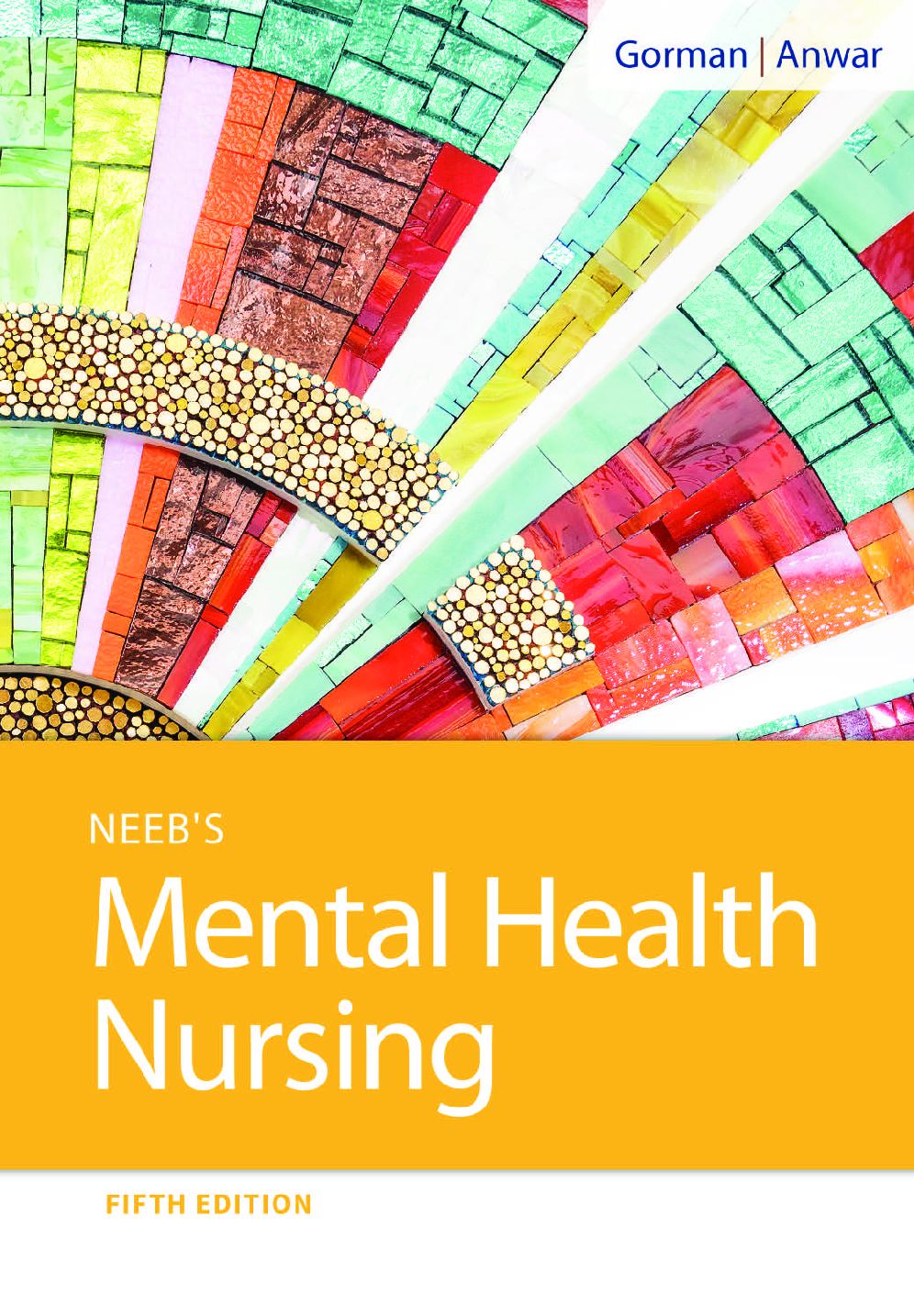
Test Bank for Gorman Neebs Mental Health Nursing 5th Edition 2019 by Gorman and Anwar
est Bank for Gorman Neebs Mental Health Nursing 5th Edition 2019 by Gorman and Anwarest Bank for Gorman Neebs Mental Health Nursing 5th Edition 2019 by Gorman and Anwarest Bank for Gorman Neebs Mental...
By Otieno , Uploaded: May 19, 2023
$15
Education> EXAM > NSG 5003 Pathophysiology Test Bank Chapter 1 to 40Pathophysiology: The Biologic Basis for Disease in Adults and Children 7th Edition South University (All)
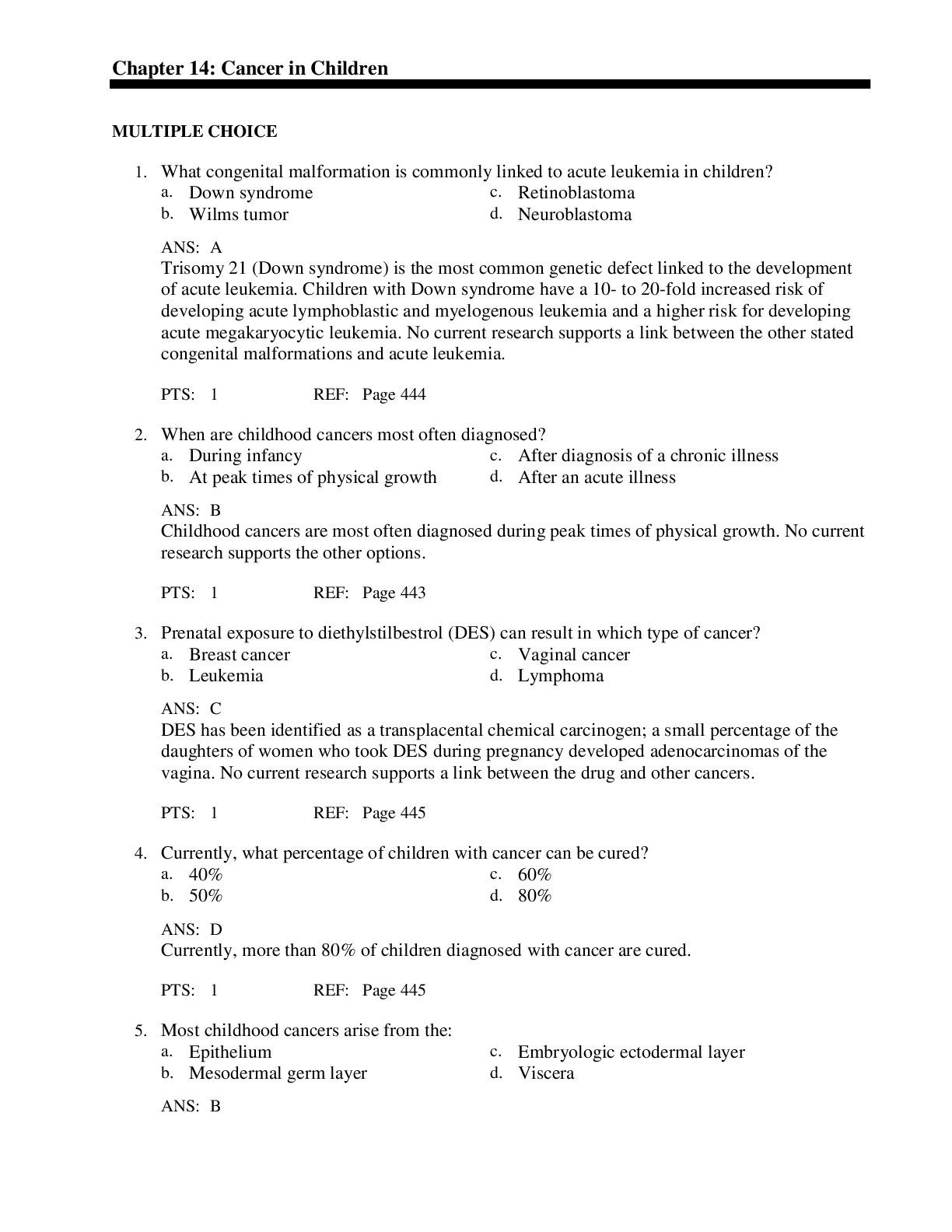
NSG 5003 Pathophysiology Test Bank Chapter 1 to 40Pathophysiology: The Biologic Basis for Disease in Adults and Children 7th Edition South University
Pathophysiology: The Biologic Basis for Disease in Adults and Children 7th Edition UNIT 1: THE CELL Chapter 1: Cellular Biology Chapter 2: Altered Cellular and Tissue Biology Chapter 3: The Cellul...
By Expert#1 , Uploaded: Sep 06, 2019
$11
*NURSING> EXAM > Darby and Walsh Dental Hygiene 5th Edition Bowen Test Bank Chapter 02: Dental Hygiene Metaparadigm Concepts and Conceptual Models Applied to Practice Bowen: Darby and Walsh Dental Hygiene: Theory and Practice, 5th Edition MULTIPLE CHOICE 1. Each of the following is a paradigm concept of the dental hygiene discipline EXCEPT one. Which is the EXCEPTION? a. Dental hygiene actions b. Health and oral health c. Environment d. Patient e. Client ANS: D The term client was selected as a paradigm concept, rather than the term patient, because the term client is broad, suggests wellness rather than illness, and represents an active rather than passive relationship with the dental hygienist. DIF: Application REF: 12 OBJ: 1 TOP: NBDHE, Provision of Clinical Dental Hygiene Services, 3.0 Planning and Managing Dental Hygiene Care 2. The surroundings in which the client and dental hygienist are interacting is the concept of a. dental hygiene actions. b. environment. c. health and oral health. d. client. ANS: B This concept includes social, ethno-cultural, financial, political, and educational factors that can be barriers or facilitators to health, oral health, and dental hygiene actions. The environment affects the client and the dental hygienist, and the client and the dental hygienist also influence the environment. DIF: Comprehension REF: 12 OBJ: 1 TOP: NBDHE, Provision of Clinical Dental Hygiene Services, 3.0 Planning and Managing Dental Hygiene Care 3. Which concept includes the surroundings where the client and dental hygienist interact? a. health/oral health. b. environment. c. dental hygiene actions. d. client. ANS: C The concept of dental hygiene action is defined as the interventions provided by a dental hygienist for the benefit of, and in collaboration with, the client to promote oral health and wellness and prevent oral disease. Darby and Walsh Dental Hygiene 5th Edition Bowen Test Bank DIF: Comprehension REF: 13 OBJ: 1 TOP: NBDHE, Provision of Clinical Dental Hygiene Services, 3.0 Planning and Managing Dental Hygiene Care 4. “Biologically sound and functional dentition” is a feature of the a. Dental Hygiene Human Needs Conceptual Model. b. Oral Health-Related Quality of Life Model. c. Client Self-Care Commitment Model. d. paradigm concept of the dental hygiene discipline. ANS: A It is one of the eight human needs related to dental hygiene care in the Dental Hygiene Human Needs Conceptual Model. It draws upon the four dental hygiene disciplinary concepts to develop an understanding of client human needs throughout the dental hygiene process of care. DIF: Comprehension REF: 19 OBJ: 2 TOP: NBDHE, Provision of Clinical Dental Hygiene Services, 3.0 Planning and Managing Dental Hygiene Care 5. Which clinical dental hygiene conceptual practice model emphasizes the client’s perceptions of and reactions to their own health status? a. Paradigm concept of the dental hygiene discipline b. Oral Health-Related Quality of Life Model c. Dental Hygiene Human Needs Conceptual Model d. Client Self-Care Commitment Model ANS: B The Oral Health-Related Quality of Life Model was developed by dental hygiene educator-researchers at the University of Missouri-Kansas City. It specifically assesses the domains of symptom status, functional status, and oral health perceptions. DIF: Recall REF: 20 OBJ: 2 TOP: NBDHE, Provision of Clinical Dental Hygiene Services, (All)
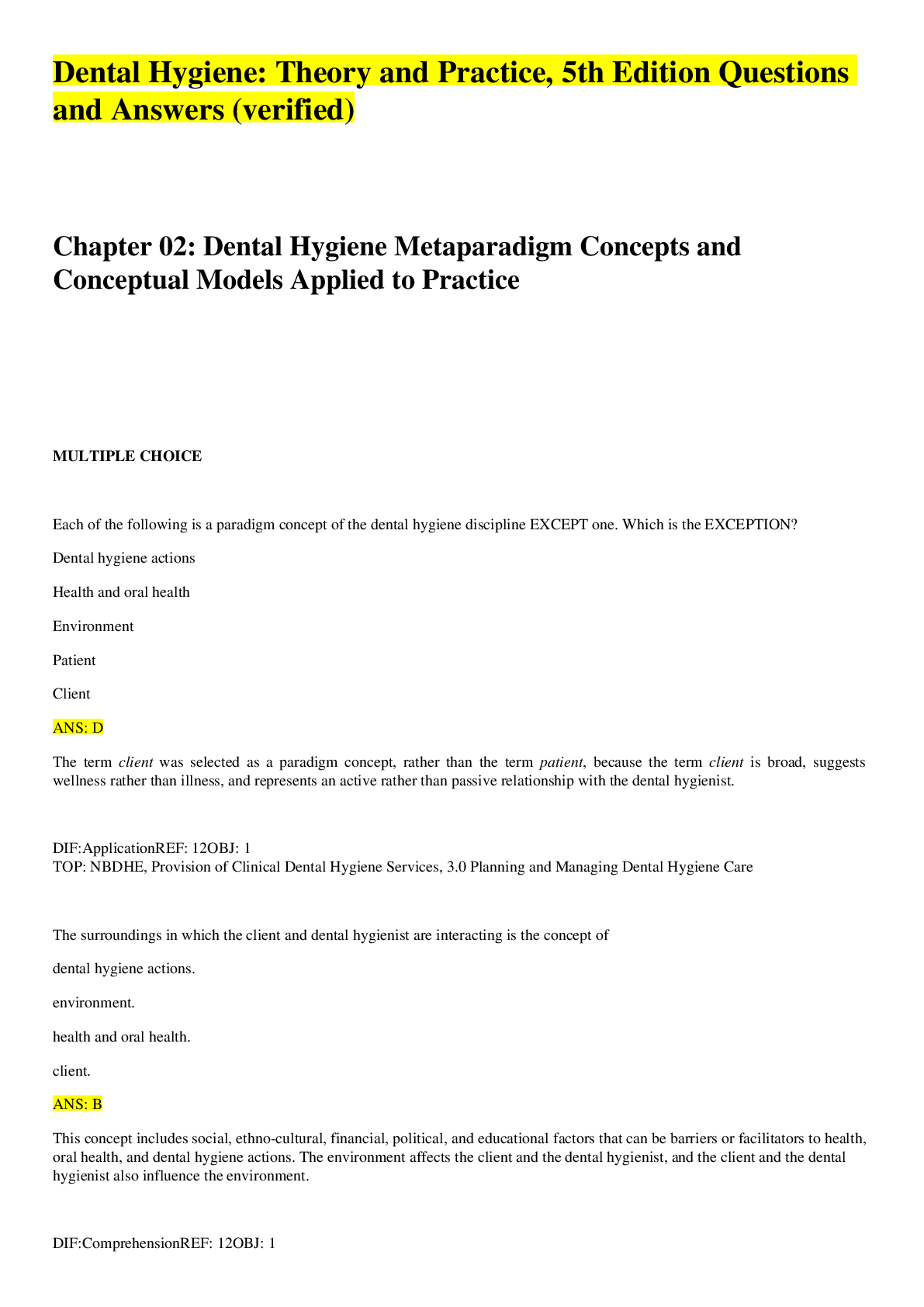
Darby and Walsh Dental Hygiene 5th Edition Bowen Test Bank Chapter 02: Dental Hygiene Metaparadigm Concepts and Conceptual Models Applied to Practice Bowen: Darby and Walsh Dental Hygiene: Theory and Practice, 5th Edition MULTIPLE CHOICE 1. Each of the following is a paradigm concept of the dental hygiene discipline EXCEPT one. Which is the EXCEPTION? a. Dental hygiene actions b. Health and oral health c. Environment d. Patient e. Client ANS: D The term client was selected as a paradigm concept, rather than the term patient, because the term client is broad, suggests wellness rather than illness, and represents an active rather than passive relationship with the dental hygienist. DIF: Application REF: 12 OBJ: 1 TOP: NBDHE, Provision of Clinical Dental Hygiene Services, 3.0 Planning and Managing Dental Hygiene Care 2. The surroundings in which the client and dental hygienist are interacting is the concept of a. dental hygiene actions. b. environment. c. health and oral health. d. client. ANS: B This concept includes social, ethno-cultural, financial, political, and educational factors that can be barriers or facilitators to health, oral health, and dental hygiene actions. The environment affects the client and the dental hygienist, and the client and the dental hygienist also influence the environment. DIF: Comprehension REF: 12 OBJ: 1 TOP: NBDHE, Provision of Clinical Dental Hygiene Services, 3.0 Planning and Managing Dental Hygiene Care 3. Which concept includes the surroundings where the client and dental hygienist interact? a. health/oral health. b. environment. c. dental hygiene actions. d. client. ANS: C The concept of dental hygiene action is defined as the interventions provided by a dental hygienist for the benefit of, and in collaboration with, the client to promote oral health and wellness and prevent oral disease. Darby and Walsh Dental Hygiene 5th Edition Bowen Test Bank DIF: Comprehension REF: 13 OBJ: 1 TOP: NBDHE, Provision of Clinical Dental Hygiene Services, 3.0 Planning and Managing Dental Hygiene Care 4. “Biologically sound and functional dentition” is a feature of the a. Dental Hygiene Human Needs Conceptual Model. b. Oral Health-Related Quality of Life Model. c. Client Self-Care Commitment Model. d. paradigm concept of the dental hygiene discipline. ANS: A It is one of the eight human needs related to dental hygiene care in the Dental Hygiene Human Needs Conceptual Model. It draws upon the four dental hygiene disciplinary concepts to develop an understanding of client human needs throughout the dental hygiene process of care. DIF: Comprehension REF: 19 OBJ: 2 TOP: NBDHE, Provision of Clinical Dental Hygiene Services, 3.0 Planning and Managing Dental Hygiene Care 5. Which clinical dental hygiene conceptual practice model emphasizes the client’s perceptions of and reactions to their own health status? a. Paradigm concept of the dental hygiene discipline b. Oral Health-Related Quality of Life Model c. Dental Hygiene Human Needs Conceptual Model d. Client Self-Care Commitment Model ANS: B The Oral Health-Related Quality of Life Model was developed by dental hygiene educator-researchers at the University of Missouri-Kansas City. It specifically assesses the domains of symptom status, functional status, and oral health perceptions. DIF: Recall REF: 20 OBJ: 2 TOP: NBDHE, Provision of Clinical Dental Hygiene Services,
Darby and Walsh Dental Hygiene 5th Edition Bowen Test Bank Chapter 02: Dental Hygiene Metaparadigm Concepts and Conceptual Models Applied to Practice Bowen: Darby and Walsh Dental Hygiene: Theory a...
By markstudys , Uploaded: Jul 26, 2022
$12
*NURSING> EXAM > TEST BANK FOR FORTINASH PSYCHIATRIC MENTAL HEALTH NURSING 5TH EDITION (All)

TEST BANK FOR FORTINASH PSYCHIATRIC MENTAL HEALTH NURSING 5TH EDITION
Chapter 01: Psychiatric Nursing: Theory, Principles, and Trends 1. Which understanding is the basis for the nursing actions focused on minimizing mental health promotion of families with chronically...
By ELIANA , Uploaded: Jul 23, 2022
$11
*NURSING> EXAM > Test Bank For Gerontological Nursing 5th Edition- Sue E. Meiner.BEST SOLUTION (All)
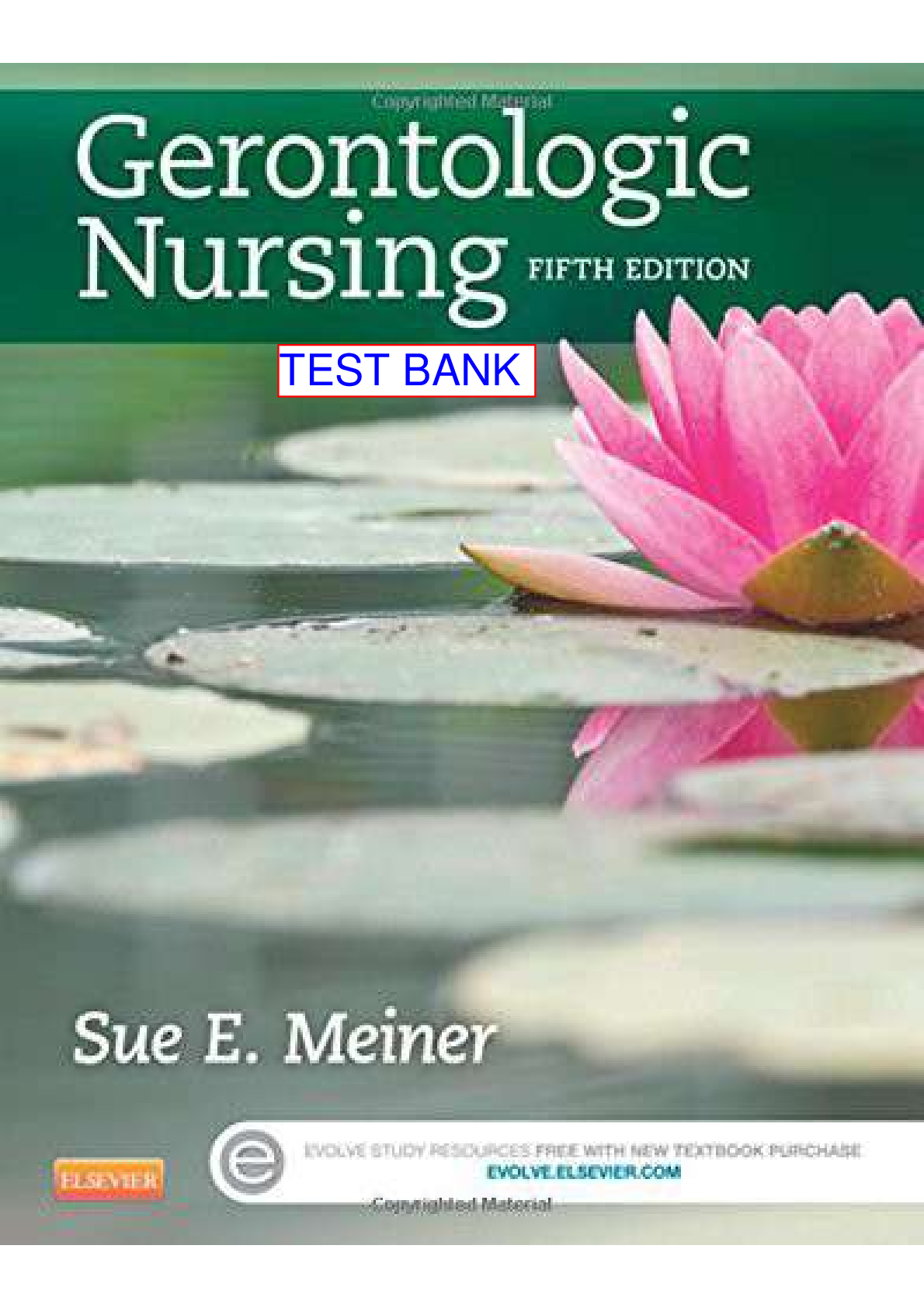
Test Bank For Gerontological Nursing 5th Edition- Sue E. Meiner.BEST SOLUTION
Meiner: Gerontologic Nursing, 5th Edition MULTIPLE CHOICE 1. In 2010, the revised Standards and Scope of Gerontological Nursing Practice was published. The nurse would use these standards to: a. p rom...
By BrendaGee , Uploaded: Jul 22, 2022
$10.5
*NURSING> EXAM > NURSING 2501( Exam 1 )Test Bank Chapter 7/: End-of-Life Care Questions And Answers/TOP SCORE (All)
 (1).png)
NURSING 2501( Exam 1 )Test Bank Chapter 7/: End-of-Life Care Questions And Answers/TOP SCORE
Exam 1 test bank Chapter 7: End-of-Life Care 1. A nurse cares for a dying client. Which manifestation of dying should the nurse treat first? a. Anorexia b. Pain c. Nausea d. Hair loss Only symp toms t...
By BrendaGee , Uploaded: Jul 17, 2022
$11
Biology> EXAM > OpenStax Microbiology Test Bank Chapter 14 : Antimicrobial Drugs (All)
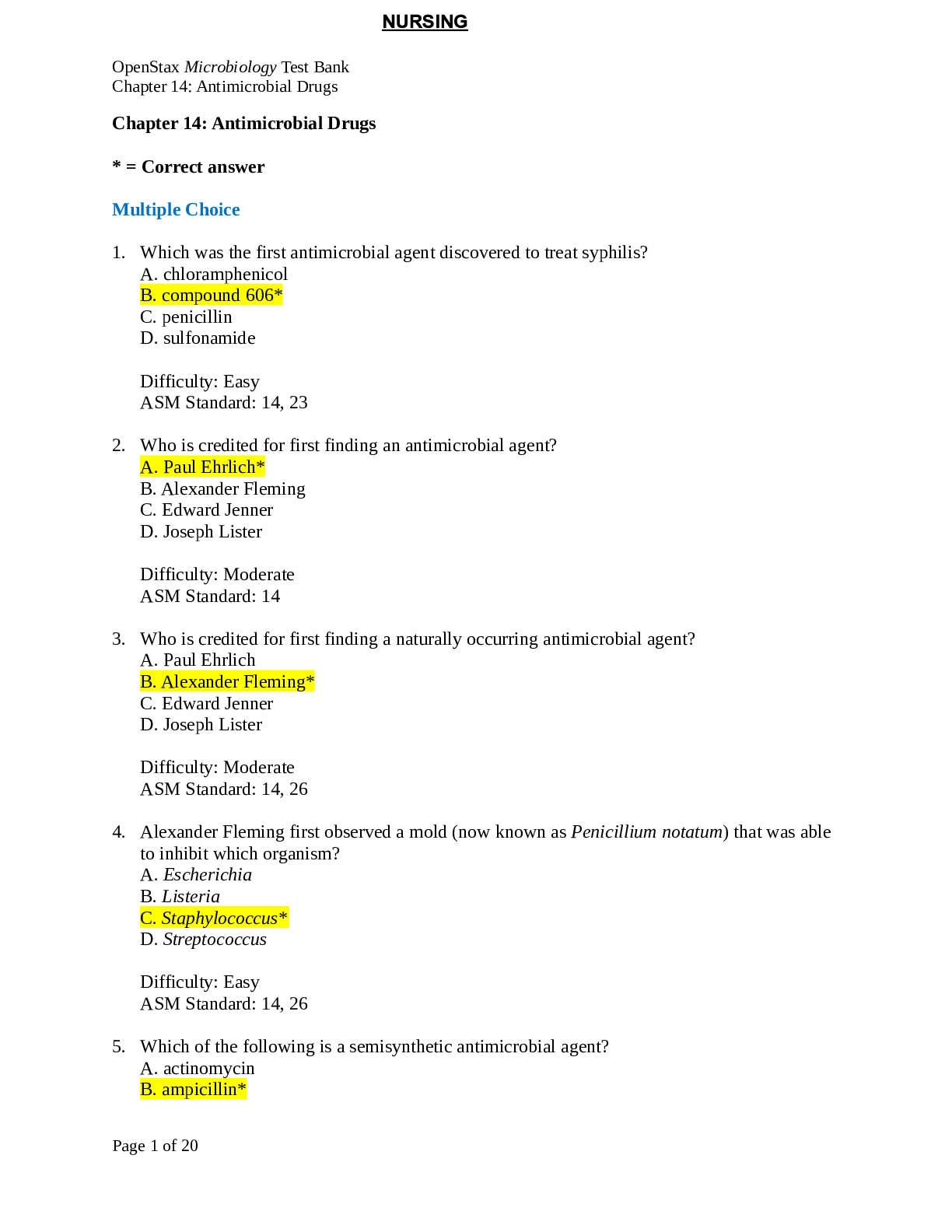
OpenStax Microbiology Test Bank Chapter 14 : Antimicrobial Drugs
Chapter 14: Antimicrobial Drugs * = Correct answer Multiple Choice 1. Which was the first antimicrobial agent discovered to treat syphilis? A. chloramphenicol B. compound 606* C. penicillin D....
By BESTMARKS , Uploaded: Jun 01, 2022
$8
Biology> EXAM > OpenStax Microbiology Test Bank Chapter 14 : Antimicrobial Drugs (All)

OpenStax Microbiology Test Bank Chapter 14 : Antimicrobial Drugs
Chapter 14: Antimicrobial Drugs * = Correct answer Multiple Choice 1. Which was the first antimicrobial agent discovered to treat syphilis? A. chloramphenicol B. compound 606* C. penicillin D....
By BESTMARKS , Uploaded: Jun 01, 2022
$8
*NURSING> EXAM > OpenStax Microbiology Test Bank Chapter 21: Skin and Eye Infections (All)

OpenStax Microbiology Test Bank Chapter 21: Skin and Eye Infections
OpenStax Microbiology Test Bank Chapter 21: Skin and Eye Infections
By ELIANA , Uploaded: May 26, 2022
$10
*NURSING> EXAM > OpenStax Microbiology Test Bank Chapter 18: Adaptive Specific Host Defenses (All)

OpenStax Microbiology Test Bank Chapter 18: Adaptive Specific Host Defenses
OpenStax Microbiology Test Bank Chapter 18: Adaptive Specific Host Defenses
By ELIANA , Uploaded: May 26, 2022
$10
Document information
Connected school, study & course
About the document
Uploaded On
Mar 31, 2021
Number of pages
13
Written in
Additional information
This document has been written for:
Uploaded
Mar 31, 2021
Downloads
0
Views
60






